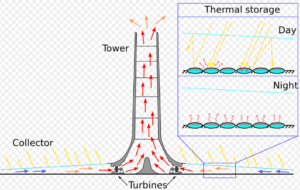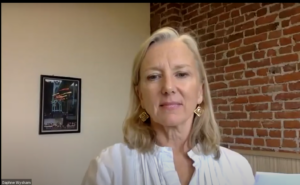Climate disasters are here. It is time to restore the atmosphere to nature’s balance. Stanford scientist & Chair of Global Carbon Project, Rob Jackson explains the new plan. Daphne Wysham from methaneaction.org; the Cambridge Methane Conference; solar towers – the last ditch effort to slash super-warming methane from the atmosphere.
Listen to/download this Radio Ecoshock show in CD Quality (57 MB) or Lo-Fi (16 MB)
“Atmospheric restoration of all gases to preindustrial levels may seem unlikely today, but we believe will eventually occur.”
– Rob Jackson

Professor Rob Jackson, Stanford & Chair of Global Carbon Project
Climate news gets more extreme all the time. But media and the public are years behind dire projections by scientists, many of them on this show. Thresholds like Polar ice melt, dying rainforests and disappearing species – when tipped we cannot go back. We can give up, grieve, or hope technology can save us from the catastrophe of technology.
A new slim hope is still possible. Although you never hear about it, one third of global warming is driven not by carbon dioxide, but methane. It is called “me-thane” in Europe, and sold as “natural gas” everywhere. Pound per pound, methane is at least 80 times more powerful as a warming gas than CO2. Fortunately, there is far less methane in the atmosphere than CO2. But like everything else, since the Industrial Revolution, humans have more than doubled the amount of methane in the atmosphere.
Now comes a group of veteran scientists saying we can take it back out. Sir David King is former Chief Scientist for the United Kingdom. He founded Centre for Climate Repair at Cambridge. It the end of September, many of the world’s leading methane experts were called to an all-day panel talking through methane removal to cut warming immediately, and buy at least a decade more time. They propose to restore the balance of methane back to pre-industrial levels, by enhancing natural breakdown of the gas.
It is a bold vision. In a sense, we broke the functioning of the atmosphere with greenhouse gas emissions. Now we repair the atmosphere, returning to the balance of gases that sustained all current life forms, including humans and our crops. And as you will hear from two guests who attended that Cambridge forum, capturing methane does not require the kind of energy and infrastructure needed to capture and store carbon dioxide. The process can use biomimicry.
Humans try to restore wetlands. The American Bald Eagle was saved and returned to the wild. Stay tuned, and you will get the vision: maybe we can restore the atmosphere. Bill McKibben of 350.org wrote about the methane challenge recently for The New Yorker magazine.
ROB JACKSON – LEADING THE METHANE CHARGE
Rob Jackson is Professor of Earth System Science at Stanford University, and a Senior Fellow of the Stanford Woods Institute for the Environment. He is Chair of the Global Carbon Project, an award-winning scientist, and photographer. His latest paper explains how methane removal can delay dangerous thresholds of warming.
Listen to or download this 20 minute interview with Professor Rob Jackson in CD Quality or Lo-Fi
This Radio Ecoshock interview is mainly based on the paper “Atmospheric methane removal: a research agenda” led by Rob Jackson, published by the Royal Society September 27, 2021. But there has been a flurry of other conferences, papers, and popular press articles about this bold methane move. I put links to many of them below. Please follow up and get up to speed on this slim new hope to stop the worst of climate disasters hitting us this decade.
Scientists differ on the methane threat. On Radio Ecoshock, Euan Nisbet described testing vials of air. He found find recent increases in atmospheric methane come mainly from East Africa bogs. From Oxford, Professor Peter Wadhams points to methane deposits frozen on the shallow Arctic sea bed. Whatever the source, all these scientists came together in a recent Cambridge conference on methane removal, headed by Sir David King, formerly the UK’s Chief Scientist. Whatever the source, they all agree now is the time to act.
HOW POWERFUL IS METHANE FOR WARMING?
The latest estimates for the relative warming power of methane compared to carbon dioxide are in this paper: Jackson, Robert; et al. (2020). “Increasing anthropogenic methane emissions arise equally from agricultural and fossil fuel sources“. Environmental Research Letters.
“Methane (CH4) emissions have contributed almost one quarter of the cumulative radiative forcings for CO2, CH4, and N2O (nitrous oxide) combined since 1750 (Etminan et al 2016). Although methane is far less abundant in the atmosphere than CO2, it absorbs thermal infrared radiation much more efficiently and, in consequence, has a global warming potential (GWP) ~86 times stronger per unit mass than CO2 on a 20-year timescale and 28-times more powerful on a 100-year time scale (IPCC 2014).”
SEE ALSO THIS COMPANION PAPER, with some of same authors
Saunois, Marielle; et al. (2020). “The Global Methane Budget 2000–2017“. Earth System Science Data. 12: 1561–1623. doi:10.5194/essd-12-1561-2020
THE BENEFITS OF RECAPTURING METHANE
The guts of climate benefits from methane removal are the Royal Society paper published September 27, 2021. It is led by Stanford PhD Candidate Sam Abernethy, with Rob Jackson as co-author. Given the huge role and long life-time of carbon dioxide, it becomes plain methane removal works mainly to buy us time. How much can we delay the onset of critical warming thresholds?
The Abernethy paper begins with a very bad scenario, called SSP3-7.0 in the new IPCC pathways system. Quote: “In SSP3-7.0, the global mean surface temperature increases near-linearly throughout the twenty-first century, passing the 2, 3 and 4°C warming thresholds above preindustrial temperature by roughly 2040, 2060 and 2080, respectively.” Four degrees C of warming before the end of this century is absolute ecologic and civilizational disaster!
From my reading in the Abernathy paper 2021, it sounds like in the worst case scenario, removing methane to preindustrial levels might only give us two to six years extra time to prevent the next threshold by action to remove CO2, refreeze the Arctic, or whatever. In other places, scientists suggest we could get up to 15 extra years to restore carbon levels in the atmosphere, if we reduce methane to pre-industrial first and soon. I guess we don’t know for sure.
It is easier to capture methane in higher concentrations, like gas wells and coal mines. We should start where methane is strongest. We need to capture only 3 billion tons of methane from the atmosphere to get back to pre-industrial levels of 750 parts per billion. That could remove about a third of global warming, buy us up to 15 years (?) more time to get off carbon dioxide and capture it, and improve our health.
Here are the technical expectations for methane removal for the worst emissions scenario (our current path) as published in this paper:
“Methane removal reduces the rate of warming from approximately 0.6°C/decade for SSP3-7.0 down to approximately 0.45°C/decade for SSP3-7.0-LowCH4 and approximately 0.25°C/decade for the drastic x2.0 scenario. The timing of reaching the warming thresholds of 2, 3 and 4°C above preindustrial is delayed linearly by effective cumulative methane removal at a rate of 3.8 ± 0.3, 4.0 ± 0.2 and 2.8 ± 0.2 years, respectively, per effective Pg CH4 removed (figure 3b). “
That comes from the September 27 paper “Methane removal and the proportional reductions in surface temperature and ozone” led by Sam Abernethy with Jackson as co-author.
Too complex sounding? Try this press release from Woods Hole, September 26, 2021, “Stanford-led research reveals potential of an overlooked climate change solution.”
Rob says: “The global methane cycle is now dominated by human activities: 60% of global methane emissions are anthropogenic”. Humans are doing it, humans can control it.
The scientists compared Shared Socioeconomic Pathways (SSP) models, high and low. For lower emissions pathways we need to remove less methane, higher more. They look at the impact of delaying methane removal by a decade or two. Approximately 10 years after methane removal about half of it would have broken down anyway. So they invent a new metric to show the effective removal including this time breakdown. They also estimate the reduction of peak temperature. and propose “Methane removal model intercomparison project MRMIP”.
The authors assume that some methane emissions from agriculture, and possibly industry, are inevitable. So we need methane removal. We may also need methane removal tech even more if natural sources ramp up, like thawing permafrost or even methane bubbling up from the sea.
Jackson doubts there will be a market for methane captured from the atmosphere. It is a public good likely paid by the public purse – to save a habitable planet! Rob Jackson’s vision for 25 years of methane capture is hard and expensive but possible. Jackson remains an optimist. He would love to see methane restored within one lifetime.
THE NEW METHANE DECLARATION
“The Declaration on Reducing Atmospheric Methane lays out a program and schedule that can be undertaken now, without waiting for a minimum number of ratifications, to research and develop a range of promising methane removal technologies, and implement those that prove safe and effective by 2023. We urge all national governments and relevant jurisdictions to adopt it, and in particular we urge the delegates at COP26 to incorporate its provisions into their undertakings to fulfill their duties under United Nations Framework Convention on Climate Change and the Paris Agreement.”
During the Ecoshock interview, Rob mentions research into gas leaks inside people’s homes. Here is the story from YaleConnections.
Tiny leaks, big impacts: New research points to urban indoor methane leaks
Rob is also a published photographer, and writes poetry. His poem “Climate Stasis” will be published in the Journal “Light” in November.
WHAT ARE “ZEOLITES” AND WHAT CAN THEY DO TO HELP?
I add one clarification. Dr. Jackson mentioned zeolites helping methane to break down faster. Zeolites are a type of mineral with strange characteristics. They are often made with forms of aluminum and silicon, like sand. But as a Scandinavian chemist discovered in the 1700’s, these rocks are porous. If you could see inside, zeolites look more like a maze of tiny tunnels, almost like a fiber or network.
There are thousands of forms of common zeolites, and they can be produced industrially as well. It turns out some zeolites, perhaps with bits of iron or copper in them, affect methane in the air. They are catalysts. Their action, called “catalysis” is not easy to understand. My very un-expert take: a chemical reaction goes faster if another substance is present. The other substance is the catalyst.
As Rob describes in our interview, zeolites could help methane “burn” so to speak. After all, a fire occurs when a substance rapidly merges with oxygen to create different compounds. Methane will burn in the air if it is concentrated enough. Fortunately for us, methane in the global atmosphere is not dense enough to just burn outright. We would all be in flames if it was.
But methane breaks down naturally, in the presence of oxygen, producing the less powerful global warming gas carbon dioxide as a bi-product. If you can get air moving rapidly over a surface containing zeolites, the methane moves through channels. It interacts with metals in the zeolites and kind of “burns” very slowly, without producing the heat of fire. The methane oxidizes, reducing it’s climate-heating threat by 80 times.
As you will hear, there are many other possible ways for methane removal, including microbes that remove methane, soil amendments to capture methane. We might mimic dust with oxidizing radicals, using iron salt aerosols, with chlorine radicals (like from sea salt). But I think by 2030 you will see sky-towers, or solar chimneys, breaking down methane, trying to save the world climate, for another few years.

Solar Updraft Tower (could be used for methane capture)
Following our second guest, we go to clips from the recent Cambridge methane conference for more from Rob Jackson, and atmospheric scientist Euan Nisbet.
================================================================
DAPHNE WYSHAM – METHANE ACTION!
Rising methane levels in the atmosphere caused a third of global warming. Did you know that? Now there is a non-profit group dedicated to methane action. The CEO is long-time activist and radio host Daphne Wysham. In her previous post with the Institute for Policy Studies in Washington, DC, Daphne successfully fought fossil fuel investments and projects. I knew her work as Editor of Greenpeace magazine, and then I learned green radio skills from Daphne’s syndicated show “Earthbeat”. Wysham is an “Influencer” with a capital “I”.

Daphne Wysham, CEO methaneaction.org
Listen to or download this 29 minute Radio Ecoshock interview with Daphne Wysham in CD Quality or Lo-Fi
WHAT IS “CLIMATE REPAIR”?
Climate repair: three things we must do now to stabilise the planet
August 12, 2021
VIDEOS FOR CLIMATE REPAIR Find a list here.
CAMBRIDGE CLIMATE REPAIR YOUTUBE CHANNEL
CAMBRIDGE “METHANE CONFERENCE” September 28, 2021 Downing College. “Methane Removal and Emerging Technologies” Tuesday, 28 September, 2021, hosted by Centre for Climate Repair at Cambridge. Full session on YouTube here.
THE ROYAL SOCIETY HOSTED AN ONLINE CONFERENCE: RISING METHANE: IS WARMING FEEDING WARMING?
Organized by Ecoshock guest Euan Nisbet, Prof Ute Skiba, Dr. Anna Jones and Prof. John Pyle. A Restricted Access journal article is here.
That series includes this:
Xin Lan, Euan G. Nisbet, Edward J. Dlugokencky and Sylvia E. Michel Published:27 September 2021
AND THIS ARTICLE WITH JACKSON
Methane removal and the proportional reductions in surface temperature and ozone
S. Abernethy, F. M. O’Connor, C. D. Jones and R. B. Jackson
Published:27 September 2021
YOUTUBE OF ROB AND DAPHNE PRESENTING AT CAMBRIDGE
Daphne Wysham at Conference: Methane Removal and Emerging Technologies, Tuesday, 28 September, 2021
IS IT TOO LATE TO HOPE?
We hear so much bad news about the climate, and lived through extreme heat, floods, fires, and storms. Hope seems like a cruel delusion. But I dug deep into repairing the atmosphere. So far it looks possible, without creating new problems.
This group of scientists and activists is going full out to bring methane restoration into the public and the halls of power. The methane activists will be at theCOP26 climate conference in Glasgow. They have top level attention. You and I need to get this project known on social media, and do what we can to get politicians at every level on board with atmospheric repair. This is one of our last chances to save a world worth living in, for our descendants, for everything alive with us. I apologize if any of this interrupts our fascination with certain doom.
My thanks to the monthly and one-time donors who keep this show on the air, and free to internet users around the world. If you can afford as little as $10 to help Radio Ecoshock, it is easy to donate here.
I’m Alex Smith. Thank you for listening to Radio Ecoshock, and still caring about our world.
Alex,
Positive things to do give some possibilities to light small candles in the increasing darkness, so Methane healing is something, no matter how small compared to what is truly needed.
I like adding Bill Rees to the mix, and today, 10/29/2021 he mentions what’s needed, even if it is seemingly impossible.
Link here: https://www.resilience.org/stories/2021-10-29/cop-26-stopping-climate-change-and-other-illusions/
I know you led the year with Bill (and Megan), but he has succinctly put the “heart of the matter” into a very few pages, and stated clearly that we need to have a conversation about that Heart. It seems true to me, and probably inevitable, (the conversation itself), and it is not just doom.
Thank you Alex for the best and most up-to-date information,
The amount of methane being released is still under estimated, there are huge sources of “leaks” occurring right now: https://www.space.com/satellites-discover-huge-undeclared-methane-emissions